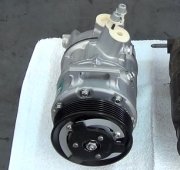The only part I'm undecided on whether to replace or not is the compressor which is the OEM. The clutch still functions, but I'm concerned about the overall internal condition of the compressor considering its age and the pressure relief valve having blown at some point.
When the system was last charged, it worked properly blowing cold air for about 20 minutes with both low and high pressures in range on the manifold gauge set. As the system continued to run, something blew dumping an excessive amount of condensation onto the floor beneath the area of the evaporator core and accumulator. Condensation also appeared on the inside surface of the windshield. Oddly though, the following day, the system held vacuum again. Later on, I leak tested with UV dye and discovered that the pressure relief valve was blown. Following all of this, the system was evacuated, vacuumed, and has remained empty for the past year or two now.
Considering the age of this OEM compressor and the pressure relief valve having blown, despite that the clutch still functions, would replacing it be recommended even if the replacement compressor would have to be an aftermarket brand due to cost?
SPONSORED LINKS
Friday, July 8th, 2022 AT 10:38 PM




